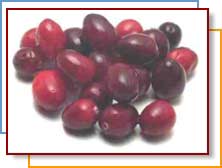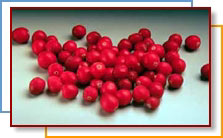
Cranberries grow on vines in boggy areas. Cranberries were first
cultivated in Massachusetts around 1815 and are only one of three major
native North American fruits. Some cranberry beds have been around for
over 100 years.
Most of the U.S. cranberry crop is grown in only five states:
Massachusetts, Wisconsin, New Jersey, Oregon, and Washington. Each year,
more than 110,000 metric tons of cranberries are produced in the United
States. Most cranberries are harvested by machine, but machines damage the
berry. Damaged berries are not suitable to sell fresh but work well for
juices, jellies, and other products. More than one-third of the
cranberries grown in the United States are made into juice. Fresh whole
berries may be purchased, but are often expensive because they have to be
hand-picked to avoid the damage caused by machine-picking.
Native Americans used cranberries for both their medicinal and natural
preservative powers. They brewed cranberry mixtures to draw poison from
arrow wounds. They also pounded cranberries into a paste and mixed the
paste with dried meat to extend the life of the meat.
The name cranberry was given to this plant because the Pilgrims believed
the plant looked like the head of a sandhill crane and was originally
named ‘craneberry.’ Over time, the ‘e’ was dropped.
|
|
Cranberry |
Serving size
1/2 cup (48g)
| Amounts Per Serving |
% Daily Value |
| Calories 20 |
|
| Calories
from Fat 0 |
|
| Total Fat 0g |
0% |
| Sodium 0mg |
0% |
| Total
Carbohydrate 6g |
2% |
|
Dietary Fiber 2g |
7% |
| Sugars 2g |
|
| Protein 0g |
|
| Vitamin A |
0% |
| Vitamin C |
10% |
| Calcium |
0% |
| Iron |
0% |
* Percent Daily Values are based on a 2,000 calorie diet. |
|
| |
|
Good, ripe cranberries will bounce, which is why they are nicknamed ‘bounceberries.’
They should be shiny and plump and range in color from bright light red to
dark red. Shriveled berries or those with brown spots should be avoided.
Cranberries do not ripen after harvest..
Store fresh cranberries in a tightly-sealed plastic bag in the
refrigerator. As with all berries, if one starts getting soft and
decaying, the others will quickly soften and decay also. Be sure to sort
out the soft ones if you plan to store them for more than a few days.
Fresh cranberries may last up to 2 months in the refrigerator. Cooked
cranberries can last up to a month in a covered container in the
refrigerator. Washed cranberries may be frozen for up to 1 year in
airtight bags.
Cranberries are often too tart to be eaten raw. Most cranberries need
be cooked before they are eaten. No matter what preparation method you
choose, cook cranberries only until they pop because overcooking gives
them a bitter taste.
Since cranberries are almost 90% water, do not thaw frozen cranberries
before cooking them. Thawing, will cause the fruit to breakdown, resulting
in soft cranberries.
Cranberries may be baked with a sweetener to make a topping or sauce, or
they can be added to baked goods, such as muffins. They are also good chopped
with oranges to make a relish.
There are four major varieties of cranberries: European, American,
Mountain, and Highbush.
American
This variety is the most common in the United States. The U.S. Department
of Agriculture uses this variety as the standard for fresh cranberries and
cranberries used for juice. This variety is bright red.
European
This variety is smaller than the American and is eaten less often than
other varieties. It is primarily ornamental.
Mountain
This variety is approximately ¼ to ½ inch in diameter and is bright red to
dark red. It is occasionally found in markets.
Highbush
This variety is primarily used for jellies, jams, and sauces. It is also used as an ornamental fruit.
Recipes
 Cranberry
Vegetable Risotto Cranberry
Vegetable Risotto
Makes 4 servings
Each serving equals 1 cup of fruit or vegetables
Ingredients
2 Tbsp butter
1 small onion, diced
¾ cup Arborio rice
1 cup low-sodium vegetable broth
1 cup sliced portabella mushrooms
1 cup diced asparagus
¾ cup sweetened dried cranberries
2 Tbsp minced fresh basil
1 Tbsp Parmesan cheese
Preheat oven to 425°F. Grease a medium casserole dish.
Melt butter in a large saucepan. Add onion and cook over medium heat until
soft. Add rice; cook for 2 minutes. Add broth; bring to a boil for 2
minutes. Stir in remaining ingredients, except Parmesan cheese.
Pour mixture into casserole dish. Cover and bake for 30 minutes. Stir in
cheese. Serve immediately.
Nutritional analysis per serving: Calories 323, Protein 8g, Fat
7g, Calories From Fat 20%, Carbohydrates 57g, Cholesterol 17mg, Fiber 4g,
Sodium 233mg.

Find more in our
recipe database!
|



